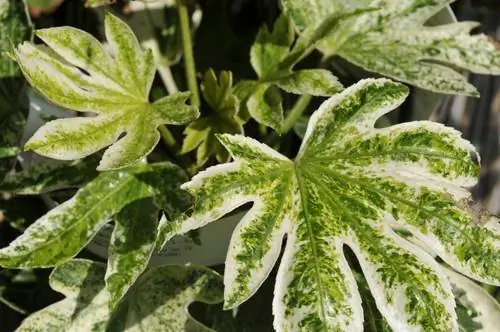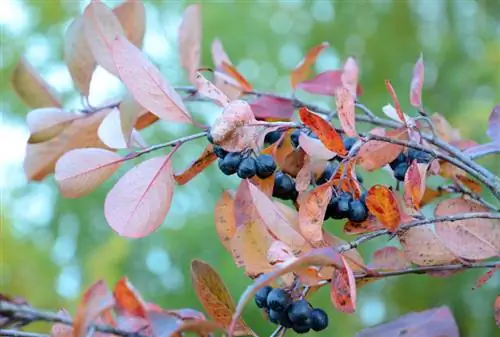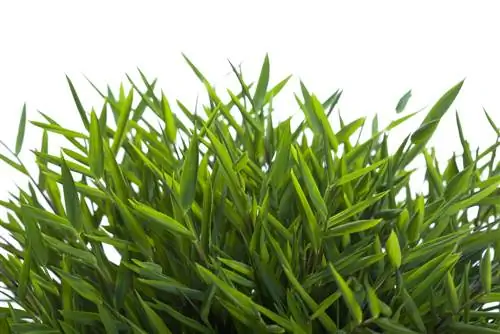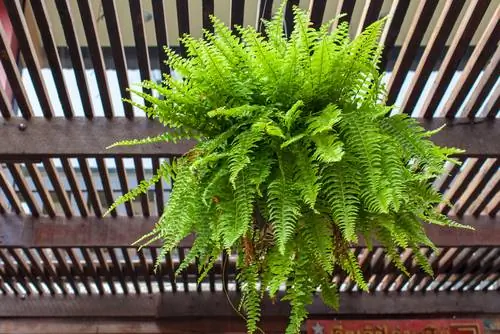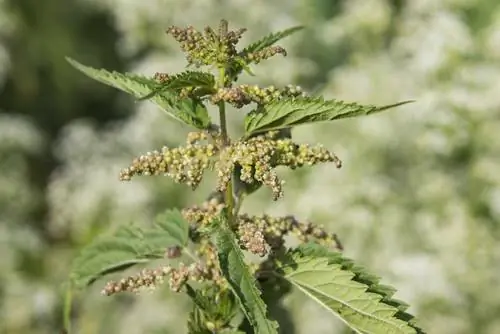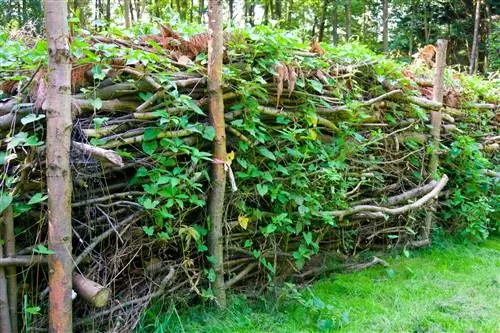- Author admin [email protected].
- Public 2023-12-16 16:46.
- Last modified 2025-01-23 11:21.
The indoor aralia or Japanese aralia (bot. Fatsia japonica) is a pretty, fast-growing houseplant from the aralia family. The plant, which is native to Asia, has strikingly large, deeply cut and palmate leaves that shine dark green. The plant is quite easy to care for and can grow very tall within a short period of time and needs a lot of space in the living room or winter garden.
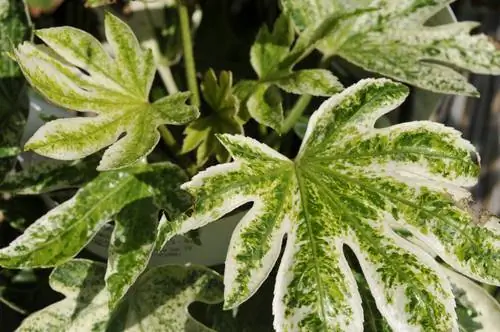
How do you properly care for an indoor aralia (Fatsia japonica)?
The indoor aralia (Fatsia japonica) is a popular evergreen houseplant known for its large, palmate and dark green foliage. It prefers a bright to partially shaded location, cool temperatures around 18°C and high humidity. The plant requires regular watering and fertilization during the growth phase.
Origin and distribution
The genus Fatsia only includes three different species, all of which are native to South Korea and Japan. The indoor aralia (bot. Fatsia japonica), which is very popular with us as a houseplant, grows wild in the vast laurel forests of tropical Japan, but is also found in South Korea and in some correspondingly warm regions of New Zealand. In the tropical and subtropical regions of Asia, Fatsia japonica is also often cultivated as a park and garden plant. There are various cultivated varieties of this species, and other Aralia plants are also found in many living rooms.
Appearance and growth
The indoor aralia is an evergreen shrub that can grow up to six meters high in its natural location. When grown indoors, the plant does not grow quite as tall, but in a suitable location it still reaches heights of up to two meters. Only a few branches sprout from the strong trunk, and the species also has difficulty branching. Young branches as well as the leaves and inflorescences are usually woolly hairy.
leaves
Characteristic of this foliage plant are the up to 40 centimeters wide, shiny, dark green and alternately arranged leaves. The seven to nine-lobed, palmate leaves are terminally attached to stems that are up to 50 centimeters long.
Flowers, flowering time and fruits
In indoor cultivation, the indoor aralia only rarely produces flowers. If so, the whitish umbels appear in late autumn and only on older plants. After fertilization, tiny, spherical and black drupes appear when ripe.
Toxicity
All parts of the aralia are poisonous to both humans and animals because of the saponins they contain. However, while humans would have to eat a lot of the green leaves to suffer from symptoms of poisoning, even small amounts of the plant are potentially fatal for cats.
Which location is suitable?
Place the indoor aralia in a light to partially shaded location, but never in full sun. Long-term direct sunlight should be avoided, especially around midday, as the leaves react very sensitively to it and burn quickly. Window sills facing south, east or west are ideal and can be shaded during midday if necessary. Bright hallways, stairwells or vestibules are also well suited for the exotic plant. Over the summer months you can cultivate Fatsia japonica in a bright and wind-protected place outdoors. If the shrub has a noticeable number of light green and/or very woody shoots, it is probably too dark.
When it comes to temperature, the indoor aralia prefers it cooler: temperatures around 18 °C are ideal for them. The humidity should be quite high, although the rule of thumb is: the higher the ambient temperature, the more often you should spray Fatsia japonica. During the winter months, the species also hibernates coolly at around ten degrees Celsius, as it takes a break in growth during this time.
Substrate
The indoor aralia is not hardy and should therefore not be planted in the garden. However, it is ideal for indoor or winter garden cultivation, as long as it can be kept cool over the winter. For this purpose, plant them in a high-quality compost-based potting soil - for environmental reasons you should avoid peat-based potting soil, especially as it also allows water to accumulate quickly - and mix it with perlite or expanded clay to improve permeability.
The indoor aralia is also very suitable for low-maintenance hydroponics.
Planting indoor aralia correctly
After purchasing, move the indoor aralia to a larger plant pot and fresh substrate as soon as possible. The best time for this measure is the beginning of the growing season between April and June, as this is when the plants root best. Choose a wide planter made of heavy material such as clay or ceramic, as Fatsia japonica grows very quickly and quickly becomes top-heavy in pots that are too small. Good pot drainage is also important, as it helps prevent waterlogging. A drainage hole at the bottom of the pot is essential.
Repotting
Since the roots of the fast-growing plant completely fill the planter within a short time, it makes sense to repot it into a larger pot and fresh soil every one to two years. The new container should only be a few centimeters larger than the previous one, as a pot that is too large will cause the roots to grow excessively. The best time to repot is spring, as soon as the indoor aralia sprouts the first new leaves and shoots.
Watering indoor aralia
During the spring shoots and during the warm summer months, you should always keep the indoor aralia slightly moist. Water them regularly, but only a little, and wait until the surface of the substrate has dried before watering again. Overwatering and waterlogging should be avoided. Instead, keep the humidity high by spraying the plant with (low-lime!) water frequently during the warm season or by placing a bowl filled with water nearby. Avoid dry indoor air even in the winter months and thus counteract spider mite infestation.
Fertilize indoor aralia properly
Between March and September, vigorous indoor aralia needs a lot of nutrients. During this time, fertilize them with a liquid foliar fertilizer. Green plants and administer this together with the irrigation water. After repotting into fresh substrate, fertilizing is not necessary for about eight weeks, as most commercially available substrates are pre-fertilized. The same applies to plant soil containing humus. Organic fertilizers such as compost, horn shavings, banana peels, etc., however, are less suitable for potted plants because the substrate lacks the microorganisms necessary to break down the nutrients. Dried coffee grounds, however, can be administered.
Stop fertilizing during the winter months between October and March.
Cut indoor aralia correctly
In principle, pruning and shaping are not necessary for Fatsia japonica, but they often make sense due to the growth of the plants. You can encourage younger indoor aralia to grow more branched and thus bushier by carefully pruning them at the beginning of the growing season, always cutting the shoots just above a so-called “eye”. Older plants can be easily limited in height by simply trimming them to the desired size. But be careful: often enough the bushes then sprout again even more strongly. Since the indoor aralia becomes woody with age, you should use sharp pruning shears (€14.00 on Amazon) to cut it back.
Propagate indoor aralia
The easiest way to propagate vegetatively is through cuttings, which develop roots very quickly. Proceed as follows:
- Cut the top shoot or side shoots resulting from pruning to the desired length.
- Remove all but the top two leaves.
- Place the shoots in a glass of water.
- The glass is placed in a bright, but not directly sunny location.
- Change the water daily.
- Plant the rooted cuttings in suitable substrate as soon as the first new shoots appear.
- Keep the substrate slightly moist.
- Slowly accustom the young indoor aralia to a brighter location.
Alternatively, you can also plant the cuttings in a nutrient-poor growing substrate. The best time to take cuttings is early summer, although the vigorous plant can still be rooted well at other times.
Wintering
Since the indoor aralia takes a winter break, a cool and bright temperature makes sense. Place the plant in a room that has little or no heating, such as a bedroom or stairwell. It just shouldn't be drafty here. Water little and do not fertilize between November and March.
Diseases and pests
Aralias are robust plants that neither diseases nor pests can quickly harm. However, an unsuitable location or incorrect care can lead to problems in the long term. Because excessive watering or even waterlogging results in root rot, which is caused by fungi and can hardly be treated: There are no effective fungicides.
Spider mites
Spider mites (also known as “red spiders”) often occur in bright locations with dry indoor air. For initial treatment, water the infected Fatsia japonica well and then place a translucent plastic bag over it. This should remain on the plant for a day or two and only then be removed. Then keep the humidity high.
Aphids
Aphids literally love to eat the aralia. As a rule, a mild infestation can be easily contained by regularly showering the affected plant.
Tip
Since the large leaves of the indoor aralia quickly become dusty, you should either shower the plant from time to time with lukewarm water or wipe the leaves with a damp cloth. Plants that are covered in dust not only look unsightly, they also quickly suffer from a lack of light and nutrients because photosynthesis does not function properly.
Species and varieties
The carpenter aralia is commercially available in various cultivars. Depending on the variety, the leaves are either solid green or yellow or variegated with white. 'Albomarginata', for example, has foliage with white edges, while 'Variegata', which only grows up to one meter high, has yellow or white spotted leaf edges. The relatively new cultivar 'Spiderweb' is also very decorative with its irregular, white-colored leaves.
In addition to the species Fatsia japonica, the related aralia family Schefflera arboricola (rayed aralia or Schefflera) and the Polyscias (pinnate aralia) are also among the most popular houseplants. The species have similar needs in terms of location and care as the room aralia, and they also socialize well.

